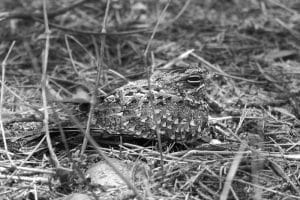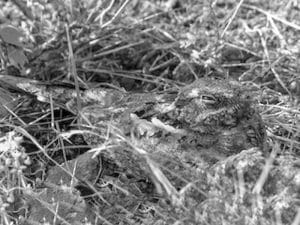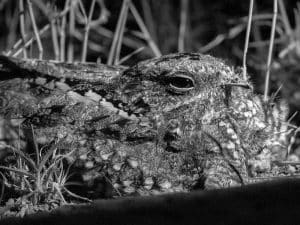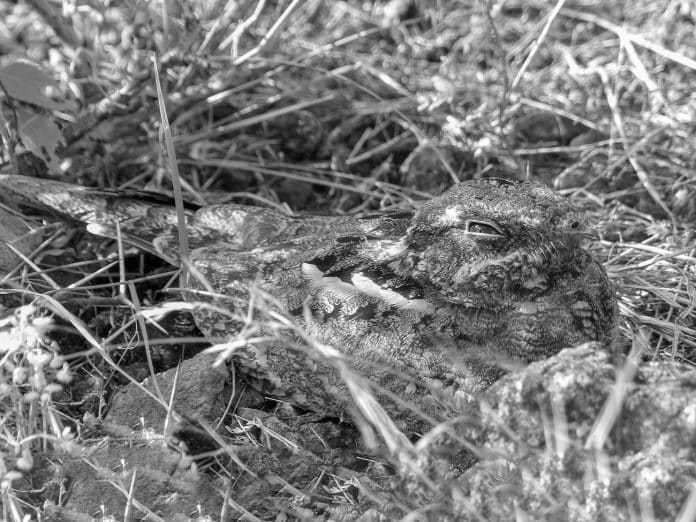Introduction to the Sombre Nightjar
Tanzania, a land of breathtaking landscapes and diverse wildlife, is home to a wide array of avian species. Among these captivating birds is the enigmatic Sombre Nightjar in Tanzania. With its unique behavior and mesmerizing appearance, the Sombre Nightjar has become a sought-after sight for birdwatchers and nature enthusiasts. In this article, we will delve into the world of the Sombre Nightjar, exploring its habitat, physical characteristics, nocturnal behavior, nesting habits, threats it faces, conservation efforts, best locations for birdwatching, interesting facts, and photography tips.
Habitat and Distribution of the Sombre Nightjar in Tanzania

The Sombre Nightjar is predominantly found in the eastern and southern regions of Tanzania, where it inhabits a variety of habitats. It is commonly spotted in open woodlands, savannas, grasslands, and forest edges. These birds have a wide distribution across Tanzania, with sightings reported in national parks such as the Serengeti, Tarangire, and Ruaha, as well as in conservation areas like Selous and Mikumi.
Physical Characteristics of the Sombre Nightjar
The Sombre Nightjar, scientifically known as Caprimulgus fraenatus, is a medium-sized bird measuring around 25 centimeters in length. It has a cryptic plumage, which blends seamlessly with its surroundings, making it difficult to spot during the day. The upperparts of the bird are predominantly brown, with intricate patterns and streaks that provide excellent camouflage. The underparts are paler, with distinct barring on the chest and belly.
Nocturnal Behavior and Adaptations
As the name suggests, the Sombre Nightjar is primarily active during the night. With a unique adaptation of large eyes and wide gape, it excels in hunting insects in low light conditions. The Sombre Nightjar is a master of stealth, relying on its exceptional hearing and silent flight to catch insects mid-air. Its soft, repetitive calls can be heard echoing through the night, creating an ethereal ambiance.
The Sombre Nightjar also possesses a remarkable ability to blend into its surroundings. Its cryptic plumage, combined with its habit of roosting on the ground during daylight hours, allows it to remain virtually invisible to predators. This nocturnal bird has evolved to thrive in the darkness, utilizing its keen senses and specialized adaptations to survive.
Reproduction and Nesting Habits of the Sombre Nightjar
During the breeding season, the Sombre Nightjar engages in courtship displays to attract a mate. Males perform intricate aerial displays, showcasing their agility and strength. Once a pair is formed, the female lays two eggs on the bare ground, often in a shallow scrape. Both parents take turns to incubate the eggs, which typically hatch after 20 to 25 days.
The Sombre Nightjar exhibits exceptional parental care, with both parents sharing the responsibility of feeding and protecting the chicks. The young birds grow rapidly and are ready to leave the nest after a short period of time. The nesting habits of the Sombre Nightjar reflect its adaptability to various environments, further highlighting its resilience as a species.
Threats and Conservation Efforts for the Sombre Nightjar in Tanzania

Despite its adaptability, the Sombre Nightjar faces several threats in Tanzania. Habitat loss due to deforestation, agricultural expansion, and human settlements poses a significant challenge to its survival. Additionally, the use of pesticides and insecticides affects the availability of prey for these nocturnal birds. Climate change and the increasing frequency of wildfires also have a detrimental impact on their habitat.
To mitigate these threats, various conservation efforts are underway in Tanzania. National parks and protected areas play a crucial role in preserving the habitats of the Sombre Nightjar. Reforestation projects, community-based conservation initiatives, and raising awareness about the importance of preserving biodiversity are key components of these conservation efforts. By supporting these initiatives, we can contribute to the survival of this remarkable species.
Birdwatching Opportunities and Best Locations to Spot the Sombre Nightjar in Tanzania
For birdwatchers and nature enthusiasts, Tanzania offers remarkable opportunities to spot the elusive Sombre Nightjar. The best time to observe these birds is during the twilight hours when they become active. The Serengeti National Park, with its vast grasslands, is a prime location to witness the Sombre Nightjar in its natural habitat. The Tarangire National Park, known for its diverse birdlife, is another excellent spot for birdwatching enthusiasts.
The Selous Game Reserve, with its mosaic of habitats, provides a unique opportunity to observe the Sombre Nightjar amidst its preferred woodland and grassland environments. The Mikumi National Park, located close to Dar es Salaam, is also a popular destination for birdwatchers, offering a chance to encounter this captivating species.
Interesting Facts and Trivia about the Sombre Nightjar
Did you know that the Sombre Nightjar has an exceptionally wide gape, allowing it to catch insects in mid-air? This unique adaptation ensures its survival in low light conditions. Another fascinating fact is that the Sombre Nightjar is a solitary bird, rarely seen in flocks. It prefers to roost alone during the day, blending seamlessly into the surroundings.
Photography Tips for Capturing the Sombre Nightjar
Capturing the beauty of the Sombre Nightjar through photography requires patience, skill, and understanding of its behavior. As these birds are primarily active during the night, it is essential to utilize appropriate camera settings to capture clear images in low light conditions. Using a tripod and a telephoto lens with a wide aperture can greatly enhance the quality of your photographs. Remember to be respectful of the bird’s habitat and avoid disturbing it while attempting to capture its essence through your lens.
Conclusion: Appreciating the Enigmatic Beauty of the Sombre Nightjar in Tanzania

The Sombre Nightjar, with its whispers of twilight and nocturnal behavior, is a captivating bird that adds to the rich avian diversity of Tanzania. From its cryptic plumage to its remarkable adaptations, this enigmatic species is a testament to the wonders of nature. By understanding and appreciating the Sombre Nightjar, we can contribute to its conservation and ensure that future generations have the opportunity to marvel at its beauty. So, venture into the twilight and embrace the mystique of the Sombre Nightjar in Tanzania.


































